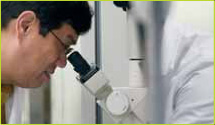We developed our Tumor-Activated Prodrug (TAP)
technology to achieve more effective, better tolerated
products for the treatment of cancer. A TAP compound is
designed to effectively kill cancer cells while minimizing
damage to the rest of the patient's body.
Every TAP compound contains a manufactured antibody, a potent cell-killing (cytotoxic) agent, and a "linker" that keeps that agent attached to the antibody until it is inside a cancer cell. The antibody part of a TAP compound binds to a target that is found predominantly on cancer cells, and enables the compound to attach specifically to these cells.
The concept of using mass-produced antibodies to selectively kill cancer cells is not a new one. The issue is that most of the antibodies created have little, if any, impact on a cancer cell once bound to it. Thus, in addition to the antibody component, all TAP compounds contain a potent cytotoxic agent that serves to kill the cancer cell.
Each TAP product candidate contains a different antibody, since the antibody component determines the type of cancer targeted. For example, huC242-DM4 contains an antibody that binds to the target, CanAg, found on many gastrointestinal cancers and AVE9633 contains an antibody that binds to the target, CD33, found on acute myeloid leukemia.
Until recently, all TAP compounds contained the same maytansinoid cell-killing agent, DM1, attached with the same linker, which forms a stable disulfide bond. In the past few years, however, we have expanded our portfolio of cell-killing agents and linkers to enable us - and our collaborators - to select the best design for each antibody and its target. For some antibodies and targets, the best design is still DM1 attached with our original linker, while for others our DM4 cell-killing agent and/or one of our alternative linkers achieves better performance in preclinical testing.
Alternative designs were evaluated for each of the four TAP compounds now in clinical testing - huN901-DM1, huC242-DM4, AVE9633, and trastuzumab-DM1 - and we believe that each has the best design for its antibody and target. Going forward, we anticipate that new TAP compounds will continue to reflect a diversity of designs.
ImmunoGen Product Candidates in Clinical Testing
We took over the clinical development of our lead compound, huN901-DM1, in 2004 and in 2005 we advanced our second wholly-owned TAP compound, huC242-DM4, into human testing. To do this, we built an in-house clinical department that also is charged with establishing a development program for each compound that, if successful, will lead to marketing approval as quickly as possible. We are preparing for the next stages in the clinical evaluation of our product candidates, as well as for the initiation of trials intended to gain marketing approval.
HuN901-DM1
Our huN901-DM1 product candidate targets an antigen, CD56, found on various types of solid tumors, including small-cell lung cancers (SCLC), carcinoid tumors, and other cancers of neuroendocrine origin. This target also is on certain "liquid" (hematological) tumors, including multiple myeloma and certain leukemias.
HuN901-DM1 originally was being assessed just for the treatment of SCLC, since virtually all cases of this highly lethal disease express CD56 and this cancer has few treatment options. After we gained control of the development of this compound, we expanded its clinical program to include evaluation in multiple myeloma, a potentially faster route to market. We are committed to advancing huN901-DM1 as quickly as possible, and are assessing further expanding its clinical program.
Initial clinical findings have been reported from our two studies with huN901-DM1 in the treatment of solid tumors (Study 001 and Study 002). Later in 2006, we expect to report additional data from its evaluation for the treatment of CD56-expressing solid tumors and also the first findings from our multiple myeloma trial (Study 003).
Compounds in Development by ImmunoGen or Our Collaborators
We reported clinical data from our Study 001 at the annual meeting of the American Society of Clinical Oncology (ASCO) in May 2005. These were the first results from the Phase II leg of this study in which all patients have relapsed SCLC/small-cell carcinoma and all receive the maximum tolerated dose (MTD) of the compound as established in the Phase I leg of this study - 60 mg/m2 when administered weekly for four weeks every six weeks. Among the eleven patients for whom efficacy information was available at the time of the ASCO meeting, two patients had pronounced tumor shrinkage. This prompted the expansion of this study to include 35 patients. We have enrolled the majority of these patients and intend to report additional findings in 2007.
In November 2005, we reported the first clinical data from our Study 002 at the AACR-NCI-EORTC International Conference on Molecular Targets and Cancer Therapeutics (EORTC). In this Phase I trial, huN901-DM1 is dosed daily for three consecutive days every 21 days. This is a dose-escalation study, which means that increasingly higher doses are administered to new cohorts of patients until the MTD is established. At the time of the last EORTC meeting, dose levels ranging from 4 to 36 mg/m2/day (12 to 108 mg/m2 over three days) had been evaluated without occurrence of the level of side effects needed to establish the MTD, and assessment of 48 mg/m2/day had begun.
Among the findings reported was the occurrence of a complete response in one of the four patients treated with a dose level of 36 mg/m2/day or more. This patient had been diagnosed with Merkel cell cancer in late 2003 and had undergone surgery, radiation therapy, and chemotherapy. Her cancer reappeared in late 2004, was found to express CD56, and she enrolled in this study. After receiving huN901-DM1, she had been in remission for more than fifteen weeks at the time of the last EORTC meeting. Another five patients had stable disease that was durable. We plan to report additional interim data from this study at the upcoming EORTC conference this November. We are still continuing to dose escalate as we have not yet encountered the toxicity needed to establish the MTD.
In these initial studies, huN901-DM1 is the only anticancer agent administered and the study patients generally have received previous treatments for their cancer. Patients with relapsed SCLC typically are unresponsive to subsequent treatments, including combinations of highly toxic drugs. Thus, we are encouraged that objective evidence of antitumor activity has been reported with huN901-DM1 in these patients.
As part of our goal of advancing huN901-DM1 as quickly as possible, in 2005 we initiated a clinical trial to evaluate it in the treatment of multiple myeloma. Approximately 70% of these tumors express CD56, and preclinical results indicate that huN901-DM1 could potentially provide a meaningful benefit to patients. Our Study 003 is underway at several sites in the US, and we hope to report the first clinical data from it at the American Society of Hematology (ASH) annual meeting in December 2006. These will be interim results, as dose escalation is still ongoing in this study as well.
We plan to report additional huN901-DM1 clinical findings in 2007, and also to provide an update on the development program for this highly promising product candidate.
HuC242-DM4
Our wholly-owned huC242-DM4 product candidate targets an antigen, CanAg, found on colorectal, pancreatic, and other gastrointestinal tumors as well as on many non-small cell lung cancers. It is a successor to our TAP compound, cantuzumab mertansine, which demonstrated evidence of antitumor activity in early clinical testing. Based on our preclinical evaluation, we expect huC242-DM4 to be more active than cantuzumab mertansine with comparable tolerability.
This TAP compound is being evaluated in a Phase I, dose-escalation study underway at the Cancer Therapy and Research Center (CTRC) in San Antonio, TX. The patients in this study all have CanAg-expressing cancer that has failed treatment with approved therapies and most of them have received multiple prior therapies. New cohorts of patients receive increasingly higher doses of huC242-DM4, administered once every three weeks, until the MTD is established. Once MTD is defined, only patients with strong expression of CanAg will be enrolled to enable us to gain additional experience with the compound in such patients.
We expect to report the first findings from this study at the EORTC conference in November 2006. Assuming its evaluation continues to go well, we plan to initiate a Phase II study with huC242-DM4 in a specific type of CanAg-expressing cancer during the first half of 2007, to be followed by a pivotal Phase II trial with the compound.
Partnerships
One of the cornerstones of our business model is to expand the application of our TAP technology by outlicensing it to other companies for use with their proprietary antibodies. These outlicenses provide us with cash, which we use to support our own product development activities. Additionally, they expand the number of TAP compounds in development, as they enable TAP compounds to be made with antibodies not available for our own product programs. These compounds, in turn, can potentially contribute favorable clinical data and provide us with significant milestone payments, manufacturing payments, and royalties.
In recent years, an additional benefit has emerged: because we have worked on so many different TAP compounds for our own programs and those of our collaborators, we have established a unique body of knowledge about the development of antibody-maytansinoid conjugates. This includes expertise in product development, preclinical evaluation, process development, and formulation development - unique and valuable know-how that increasingly is being recognized.
Our Collaboration with Genentech
In 2006, Genentech advanced trastuzumab-DM1 into Phase I testing for the treatment of HER2-expressing metastatic breast cancer, and also established an agreement with us to develop a commercial-scale manufacturing process for this TAP compound.
Trastuzumab-DM1 was developed under a 2000 agreement that grants Genentech the exclusive right to use our maytansinoid TAP technology (e.g., DM1, DM4) with antibodies to HER2. The original 2000 agreement entitled ImmunoGen to receive milestones potentially totaling $37.5 million plus an upfront payment of $2 million, manufacturing payments, and royalties on the sales of any resulting product. We earned a $2 million milestone payment in January 2006 with the advancement of trastuzumab-DM1.
In May 2006, we agreed to develop a process that Genentech could use to manufacture trastuzumab-DM1 at amounts up to and including commercial scale. We have unique experience in this area because we make TAP compounds for ourselves and all of our partners at our manufacturing facility in Norwood, MA, and we developed the conjugation process for each compound. Under the May 2006 agreement, we receive research support payments from Genentech for our work. Additionally, the 2000 HER2 agreement was amended to include, potentially, another $6.5 million in milestone payments - bringing the total to $44 million - and increased royalties on sales.
Genentech now has the exclusive right to use our TAP technology with antibodies to four different targets - HER2 and the three undisclosed targets licensed in 2005. Genentech also has the right to test our TAP technology with other targets and take additional licenses.
Our Collaboration with sanofi-aventis
In 2003, we entered into a discovery, development and commercialization collaboration with sanofi-aventis (then Aventis). ImmunoGen was selected for this partnership because of our capabilities in the development of antibody-based anticancer treatments including our TAP technology.
Sanofi-aventis has exercised both of its options to extend the research portion of our collaboration, so this part of our relationship now continues through August 31, 2008. When it ends, we will have earned more than $90 million in committed funding over the five years of our research collaboration.
After August 2008, ImmunoGen continues to be entitled to receive a return on each product candidate included in the collaboration - milestone payments potentially totaling $21.5 million to $30 million per antigen target, manufacturing payments, and royalties on sales - and to have certain co-promotion rights. Additionally, after August 2008, sanofi-aventis will need to take a license to use our TAP technology with antibodies to targets that were not part of the collaboration.
As part of our discussions with sanofi-aventis, it was agreed that, effective September 1, 2006, we are no longer obligated to present targets for antibody-based anticancer treatments to the collaboration. Thus, as of this month, we are free to use such targets to develop compounds for our own product pipeline. Also removed were certain restrictions related to our establishment of new licenses with other companies. We now have a much greater opportunity to create additional ImmunoGen-owned compounds and to establish new collaborations with other companies while, at the same time, working with sanofi-aventis to advance the compounds we have developed together.
Those compounds include the three product candidates that sanofi-aventis licensed in 2003 from our preclinical pipeline - AVE9633, AVE1642, and SAR3419 - plus additional compounds that our two companies created together. AVE9633, a TAP compound, targets CD33 and is being evaluated in two Phase I studies - one in the US and one in Europe - for the treatment of acute myeloid leukemia. We expect the first clinical findings with AVE9633 to be reported at the ASH meeting in December. Preclinical findings were reported with AVE1642 and SAR3419 in April 2006, and both of these compounds are advancing towards clinical testing. AVE1642 is a "naked" (non-conjugated) antibody that binds to IGF-1R. It has potential utility in the treatment of a number of different types of solid tumors. The TAP compound, SAR3419, targets CD19 and has potential utility in the treatment of certain B-cell malignancies including non- Hodgkin's lymphoma.
Our Latest Collaboration: Biotest AG
In July 2006, Biotest AG licensed the exclusive right to use our TAP technology with antibodies to a target found on multiple myeloma and other cancers. As with our other technology outlicense agreements, this license entitles ImmunoGen to an upfront payment and significant potential milestone payments, plus manufacturing payments and royalties on the sales of any resulting products.
Additionally, this agreement grants us the right to opt in on the US development and commercialization of any resulting compound. We can exercise this right at certain stages of the testing of the compound in humans, so we will know the clinical findings to date when making our decision. Should we elect to opt in, we would pay Biotest a fee, forgo our right to future milestone payments and royalties on US sales, and share equally the costs of US product development and commercialization. We would then be entitled to half of the profits on the US sales of the compound. Thus, this agreement provides us with another way to potentially derive a significant financial return from the application of our technology with little risk to ImmunoGen.
Other Partnership Updates
In January 2006, Millennium Pharmaceuticals, Inc. reported that they were discontinuing development of MLN2704, a TAP compound targeting the Prostate-Specific Membrane Antigen (PSMA). Millennium previously had disclosed that they were reviewing this program because of concerns about the compound's tolerability and certain economic challenges. Millennium retained their right to use our TAP technology with antibodies to PSMA. In March 2006, they extended the agreement that enables them to test our technology with antibodies to other targets for an additional year.
In the past twelve months, Biogen Idec and Centocor - both leaders in the development of antibody-based therapeutics - reported preclinical data on TAP compounds. We are pleased with the progress being made by these companies.
Looking forward, we expect another collaboration product candidate to advance into clinical testing in the coming weeks, an additional TAP compound to enter the clinic in the first half of 2007, and two to three more TAP compounds to advance into clinical testing during our 2008 fiscal year. We expect the body of clinical data on TAP compounds - ours and those of our collaborators - to increase substantially going forward.









